Aesthetic and Functional Nose Concerns
- ByMedical Content Team
- Medically Reviewed byDr. Sabine Kulhanek
Fact checked
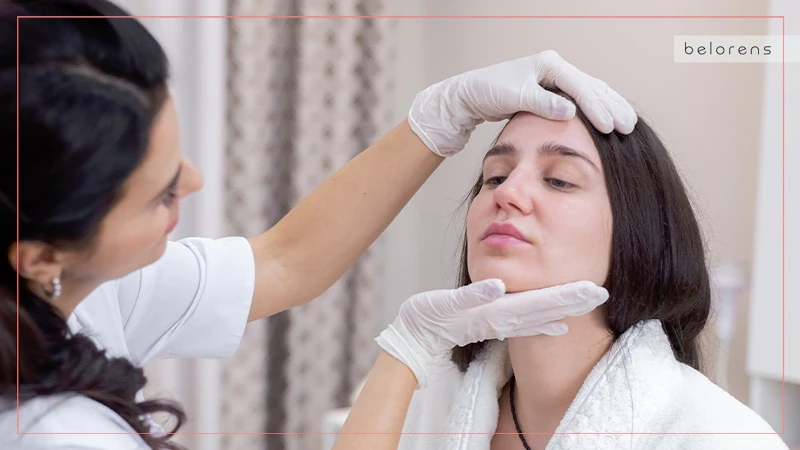
Table of contents
When it comes to the aesthetic concerns people feel about the shape of their facial features, none has more diversity than the nose. From a dorsal hump and saddle nose to a droopy tip and wide wings, noses have a broad array of physical characteristics that some people see as “imperfections” and seek to fix through surgical intervention. You may have a congenital or post-traumatic nasal deformity that makes your nose look unnatural and weird-looking or you may have a normal and natural nose shape that simply isn’t what you want.
While today rhinoplasty or nose surgery is most often done as an elective procedure for cosmetic purposes, it may also be used to fix a functional nose problem that has caused breathing difficulties. No matter whether one has got their nasal shape and problem because of heredity, race, and ethnicity, or a physical injury they sustained at one point in life, rhinoplasty can help the appearance — and/or function — of the nose change for the better.
In this article, we are going to discuss the most common nose concerns that can be corrected or improved with rhinoplasty.
Aesthetic Nose Concerns
Dorsal Hump
Other names: humped nose, nasal bump
One of the most common reasons people consider rhinoplasty is a prominent bump or hump on the dorsum (bridge) of the nose. This is a result of excess nasal bone and cartilage on the bridge, making the nose look large and masculine, especially when viewed in profile. While some people may find a small nasal hump attractive in men, almost all agree that it’s not an aesthetically pleasing feature in women as it makes the face less feminine.
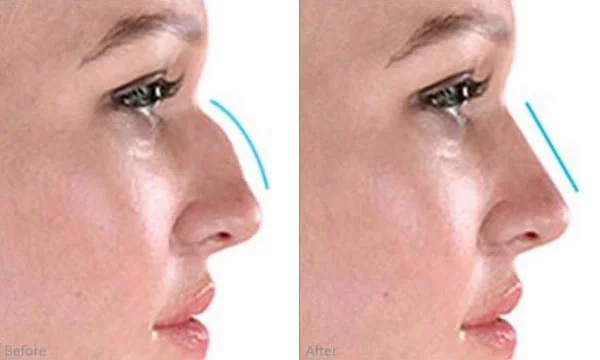
The presence of a dorsal hump is often related to hereditary factors and it runs in some families. It may also be caused by physical trauma or surgery. Depending on the location of the hump, it may be made of bone or cartilage tissues. If it is located at the upper part of the dorsum, it is bony and if it is on the lower part, it is made of cartilage. In any case, a dorsal hump can be removed through rhinoplasty and a bone shaving technique to make the nasal bridge straight or even give it an inward curve, enhancing the profile of the face.
Hooked Nose
Other names: aquiline nose, roman nose
A hooked or hook nose, sometimes called an ‘aquiline nose’ or a ‘roman nose’, has a high bridge and a droopy tip. A hook nose is actually a nose with a dorsal hump and a tip that points downward, creating a convex dorsal curve and a shape that resembles an eagle’s beak, which is why it is called ‘aquiline’ (like an eagle). This nose shape is sometimes called ‘hawk nose’ when the nasal tip is more pointed and the bridge is thinner.
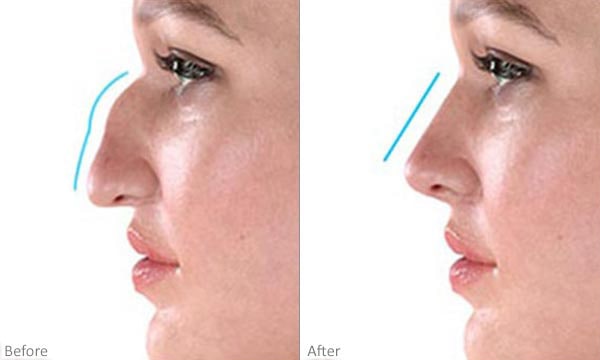
Although a typical hooked nose always has a nasal hump, not all noses with humps are considered hooked because a nose may have a dorsal hump but the tip isn’t drooping and may even point upward. Hooked noses are more prevalent among people from certain ethnicities and geographical regions, such as Native Americans, Jews, Latinos, Southern Europeans, Middle Easterners, and people from the Mediterranean and Central Asia.
Also read: Nose Shapes Across Ethnicities
A hooked nose was historically associated with good personal qualities such as intelligence, nobility, and power. Today, an aquiline nose connotes masculinity and some people still consider it attractive in men, but it is disfavored by many others as big and ‘ugly’, especially in women.
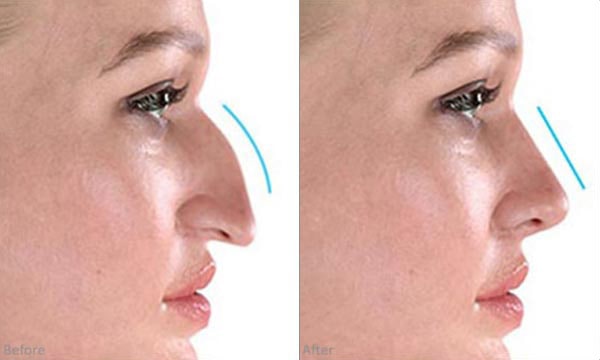
This nose shape is especially noticeable from the side view and is hardly visible when you look at it from the front. A rhinoplasty procedure can completely fix a hook nose and significantly improve an individual’s side profile. In this procedure, a plastic surgeon softens the contours of the nose by shaving the bumpy structure to lower the bridge and reposition the cartilages of the nasal tip (tip rotation).
Droopy Nasal Tip
A common issue people have with the tip of their nose is droopiness. A droopy nasal tip can be caused by a lack of support due to insufficient cartilage and weak structure at the tip or otherwise over-projected cartilage, as well as a too-long septum or excess skin. This makes the nasal tip point downward and close to the lips, creating a too small angle between the nose and the lips (nasolabial angle), which is not aesthetically pleasing.
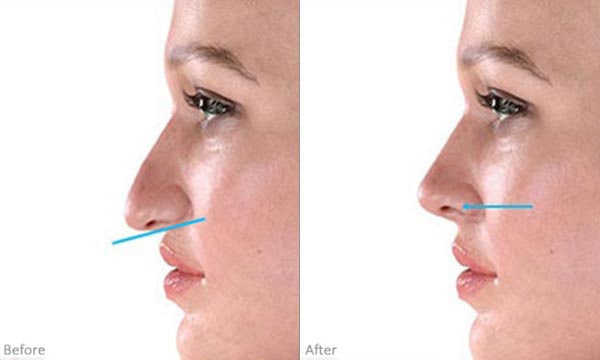
A drooping nose tip can be corrected with a rhinoplasty technique that is more technically known as tip rotation. Depending on the cause of the droopiness, a surgeon uses different techniques to elevate the tip and improve the contours of the nose. If the problem is due to a lack of cartilaginous support, the surgeons may adopt a cartilage grafting approach to provide support for the fleshy tissue of the tip. But if it is due to excessive cartilage or tissue, the doctor removes some of them or repositions and tightens them with sutures to create the ideal nasolabial angle. The ideal nasolabial angle is 100 to 150 degrees for women and 90 to 95 degrees for men.
Bulbous Tip
Other names: boxy tip
When talking about different nose shapes, people often describe a nose with a big and round tip as ‘bulbous’. In some people, the nose has a broad and rectangular appearance, which is sometimes referred to as a ‘boxy’ tip. A bulbous or boxy nose tip is due to the shape and spacing of the nasal cartilages and extremely thick skin, making the nose look too big and disproportionate to other facial features. A bulbous nose is normally a genetic or ethnic physical trait.
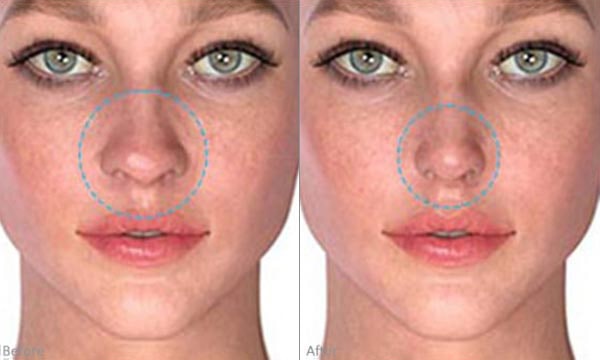
This is one of the most common aesthetic nose concerns people seek to correct with rhinoplasty. A rhinoplasty that is focused on refining the nasal tip is called a tip-plasty. During the procedure, a plastic surgeon removes some of the excess cartilage and tissue and repositions the cartilages to narrow the tip and create a better definition for the nose.
Crooked nose and deviated septum
A crooked nose is a nose that doesn’t have a straight bridge. Unlike a dorsal hump, this nasal deformity is especially noticeable when looking at the face from the front view. Depending on the severity of the condition, a crooked nose may only be a cosmetic nose concern or affect the breathing as well, making functional rhinoplasty or septoplasty necessary.
Also ريالead: What Happens before Rhinoplasty and How to Prepare for the Procedure
A crooked nose is often the result of a septal deviation (deviated septum), which is when the septum (the wall separating the nostrils) shifts to one side, blocking one of the nostrils or making it narrower and causing breathing difficulties.
Most of the time, nasal crookedness is caused by a deviated septum as a result of a broken nose. However, some people are born with this deformity. A congenital crooked nose is caused by abnormal nasal bone or cartilage development. Some people may also have acquired the condition by sustaining a nasal septum dislocation during birth. In rare cases, a crooked nose may be caused by severe infections or tumors.
There are 3 main types of crooked noses:
- C-shaped (or reverse C-shaped)
- S-shaped (or reverse S-shaped)
- Linear
In a C-shaped nasal deformity, the base and tip of the nose are in the right position but the middle part of the bridge is off-center, creating a curve in the shape of a C or reverse C letter. This is often because of a deviation in the bony (upper) part of the nose, which is why it is called a bony deviation.
In an S-shaped crooked nose, both the nasal bone (upper part of the bridge) and cartilages (lower part of the nose) are simultaneously twisted in opposite directions, forming the shape of an S or reverse S letter on the bridge. That is why it is sometimes called a bony-cartilaginous deviation.
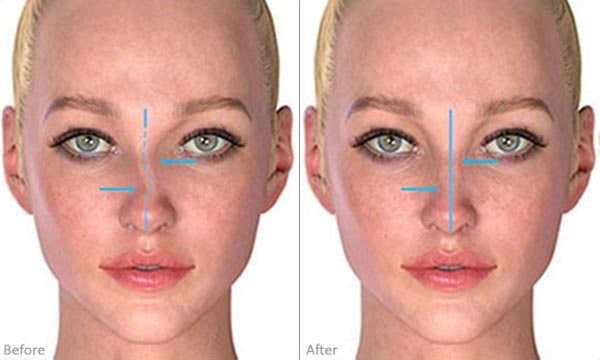
In linear crookedness, there is no twist in the nasal bridge but it is leaning to one side in a sloping position with the tip having the biggest deviation from the vertical midline of the face because of the deviation of the lower (cartilaginous) part of the nose (cartilaginous deviation).
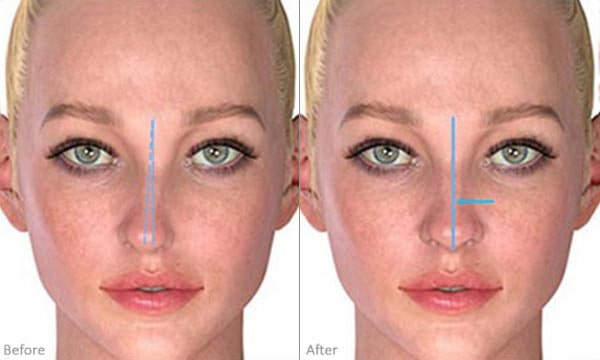
A crooked nose can be corrected with rhinoplasty for cosmetic, functional, and both purposes. If the problem is caused by a severe septal deviation that has caused nasal obstruction and breathing difficulties, it can be fixed with a septoplasty surgery, in which a plastic or ENT surgeon moves the septum to the right position to remove the nasal blockage. At the same time, the surgeon can also address the cosmetic concerns by fixing the bones and cartilages in the right position to correct the asymmetry.
Interestingly, it is estimated that 80 percent of people have a degree of septal deviation but as the majority of which is mild and barely perceptible, most people don’t actually need surgery. However, in cases where a deviated septum is more severe and has made the nose crooked but it still doesn’t have a negative effect on breathing, cosmetic rhinoplasty can address the aesthetic concerns of patients who want to have a symmetrical nose.
Nasal asymmetry
No one is born with perfect symmetry. Almost all of us have some degree of asymmetry in our faces, but in most people, the imbalance is so slight that it is hardly noticeable. However, facial asymmetry sometimes has a clear effect on your appearance, making you want to look for a solution.
An asymmetry in the nose is one of the most common concerns people seek a surgical or non-surgical solution to fix. The causes of a nasal imbalance are numerous, including a congenital defect, a nasal fracture, or a botched rhinoplasty.
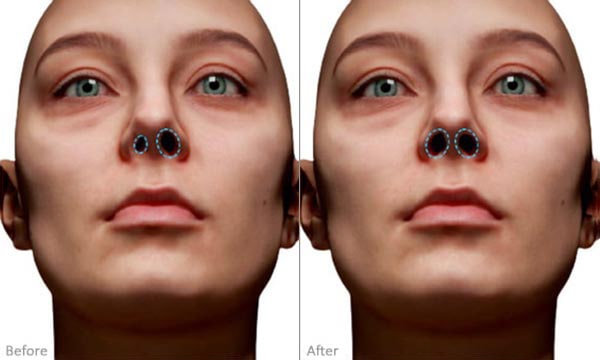
Nasal asymmetry comes in different forms. The most common form is a crooked nose and asymmetrical nostrils, which may be caused by a deviated septum or a badly-performed nose surgery. Plastic surgeons adopt invasive and non-invasive approaches to correct nasal asymmetry. While a filler injection procedure might work for a slight asymmetry in the nose, more serious cases require a rhinoplasty (revision rhinoplasty if it’s caused by a previous surgery). Revision rhinoplasty for fixing an asymmetric nose requires extensive expertise and experience, so you should be extra careful when choosing a rhinoplasty surgeon.
Wide Nose and alar flare
A great number of people looking for rhinoplasty are unsatisfied with the width of the bottom part of their nose. This is something that most people talk about as ‘wide nose’ or ‘wide nostrils’ and is technically known as ‘alar flare’.
An alar flare is when the nostrils and nasal wings are too wide and enlarged, which is typically characteristic of certain ethnic groups including the black people. A nose with such a shape is commonly referred to as a ‘Nubian nose’. This problem is especially noticeable when smiling because the facial muscles pull the nostrils laterally, making them look even wider.
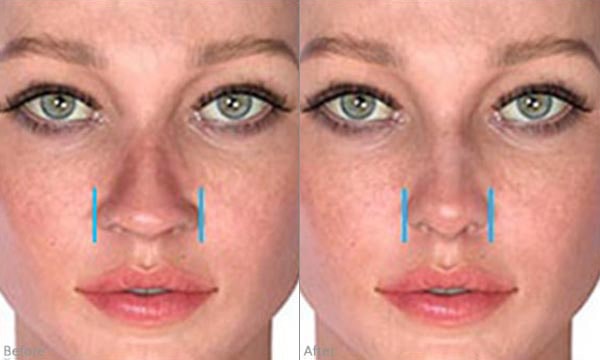
Plastic surgeons use a rhinoplasty technique known as ‘alarplasty’ or ‘alar base reduction’ to reduce the width of the nostrils and narrow the bottom of the nose. In this procedure, surgeons make two incisions in the creases along the alar rim and remove some of the tissue and then stitch them up to reduce the width of the nose wings (alae) and consequently the nostrils' size.
An alar flare is an aesthetic nose concern and should not be confused with nasal flaring, which is a functional issue and is also sometimes called ‘nostril flaring’ (see Functional Nose Concerns).
Flat Nose Bridge
Commonly called a flat nose, this nose concern is more common among Asian and Black people and sometimes is due to a genetic disorder. A flat dorsum or nasal bridge is lower than normal, making the nose look wide in the front view and disproportionately low in profile. Correcting a flat nose with rhinoplasty often involves a cartilage grafting procedure to increase the height of the nose. Occasionally, a nasal implant may also be used to raise the nasal bridge and improve its contour.
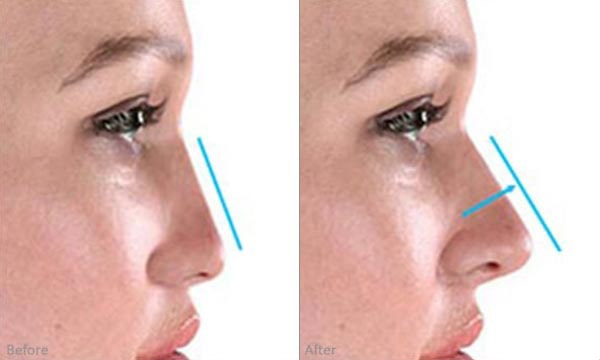
Saddle Nose
As the name suggests, a saddle nose deformity occurs when there is a depression in the bridge of the nose, shaped in the form of a horse’s saddle. It is the opposite of a dorsal hump, that is the dorsum collapses and is lower, instead of higher, at one point. A saddle nose deformity is a complex congenital or acquired problem that may occur for several reasons. Causes include physical trauma, bacterial infection, inflammation of nose blood vessels, intrauterine trauma, intranasal drug abuse, etc.

A saddle nose deformity comes in varying degrees. In some cases, the depression is very deep, which both gives the nose an unsightly appearance and makes breathing difficult for the affected individual. This makes it necessary for the individual to have a rhinoplasty to address the aesthetic and functional problems caused by the deformity. However, slight saddle deformities normally do not interfere with breathing. They can be corrected with a rhinoplasty or nose fillers, though the latter provide temporary results.
The surgical correction typically involves a grafting procedure, in which the surgeon reconstructs the dorsum by harvesting cartilage from other parts of the body such as ribs or ears, and transplanting it into it.
Pointy Nose
A pointy nose is the opposite of a bulbous nose. Although people tend to like noses that have a more defined and slim tip than a big and round one, an extremely (and literally) sharp nose is not normally considered attractive — though, figuratively speaking, a person with a sharp nose has a keen sense of smell and in this sense, it is considered a positive attribute.
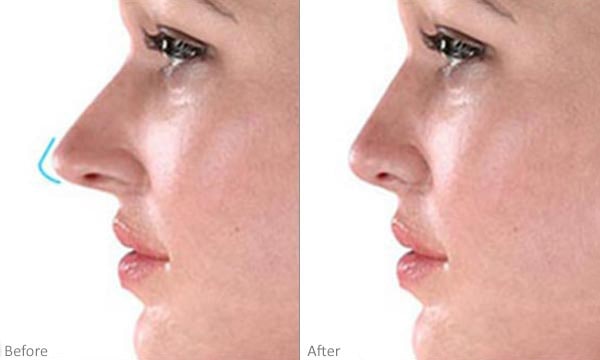
Anyway, a pointy nasal tip is due to the shape of the cartilage at the tip of the nose and is the result of protruding cartilage or too long septum. This issue is easily treatable with a rhinoplasty, or more precisely a tip-plasty. With this procedure, the plastic surgeon removes some of the excess sharp cartilage of the tip of the nose, making it less pointed and projected to give the nose improved contours. This will also reduce the height of the nose and make it more proportional to other facial features.
Polly Beak
Other names: parrot beak
Also known as a parrot beak, a polly-beak deformity refers to a phenomenon when there is a bulge just above the nasal tip (supratip). This cosmetic nose problem actually involves a dorsal hump at the lowest part of the bridge, which makes the nose look like a parrot’s beak.
A polly-beak deformity may be due to the natural shape of the nose, which is the result of an overgrowth of the septal or nasal tip cartilage. It may also be a post-rhinoplasty problem caused by the formation of scar tissue after a previous nose surgery or the surgeon not correctly trimming down a dorsal hump in a previous rhinoplasty.
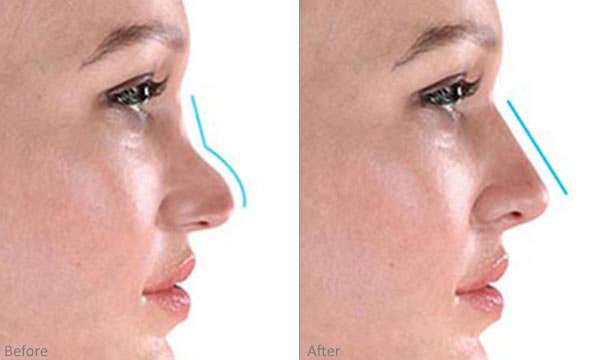
A parrot beak deformity is best visible in the profile view, though it slightly affects the front view as well, making the nose tip look droopy. The problem can be fixed with rhinoplasty, through which the surgeon removes the supratip protrusion and slightly elevates the tip to give the nose a smooth and well-defined contour.
Pinched Nose
A pinched nasal tip deformity refers to an extremely narrow tip as if it has been firmly pinched. Just like an alar retraction, a pinched nose is also often the result of a botched nose job, in which a surgeon has cut out too much cartilage in an effort to refine the tip of the nose or sutured the cartilages inappropriately. A pinched nose deformity doesn’t typically show immediately after surgery but it becomes evident after the swelling has completely disappeared and the nose has taken its final form.
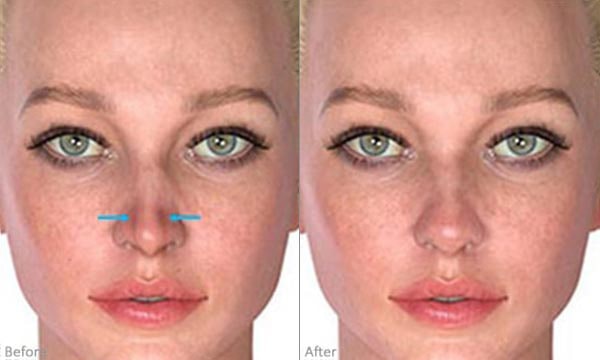
A pinched nose tip can also be a congenital defect or be acquired due to an injury, causing the nasal cartilage to collapse. In any case, it can be corrected with a rhinoplasty (primary or revision). The surgeon usually performs a cartilage grafting procedure to give the tip of the nose additional support.
Inverted “V” Deformity
The appearance of an inverted V-like shape on the bridge of the nose is typically a complication from a previous nose surgery. This often happens after a hump removal procedure and is due to the collapse of the upper lateral cartilages and the loosening of their attachment to the nasal bone. Besides the cosmetic aspect, this phenomenon may create breathing difficulties as it causes the collapse of the nasal valves (nasal valve stenosis), leading to the obstruction of the airflow.
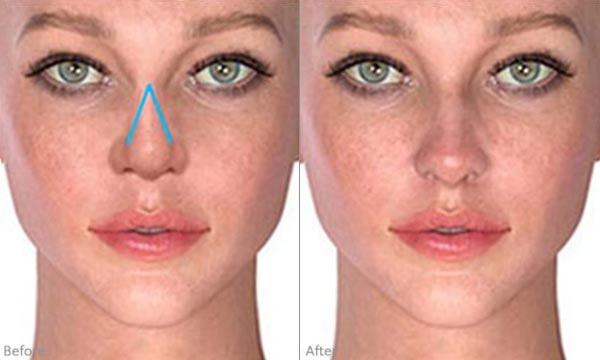
An inverted V deformity is characterized by the narrowing of the nasal bridge as we move upward from the nasal tip. If you have an inverted V problem and run your fingers upward along the sides of your nose, you will feel a hollow spot as you reach the end of the cartilaginous part of the bridge and may even feel the edges of the nasal bone as you move further.
The best solution to an inverted V deformity is a surgical procedure. In a revision rhinoplasty for an inverted V nose, surgeons usually take a cartilage grafting approach to repair collapsed upper lateral cartilages and fix the problem. In cases where the condition doesn’t affect breathing, injectable fillers may be used to improve the appearance of the nose.
Alar Retraction
Other names: alar rim retraction
Sometimes called alar rim retraction or alar notching, this is a nasal deformity in which the alar rim is pulled upward, creating an indentation on the edge of the nasal wing (ala) and exposing more of the inside of the nostril. In more obvious cases, the nostril is in a triangle shape in the side view.
The most common cause of alar retraction is a poorly-performed rhinoplasty in the past. An inexperienced surgeon may remove too much of the alar cartilage and tissue, which will leave a notch on the rim of the alae. An incorrect suturing in the alar area may also cause the rim to retract and move upward after healing.
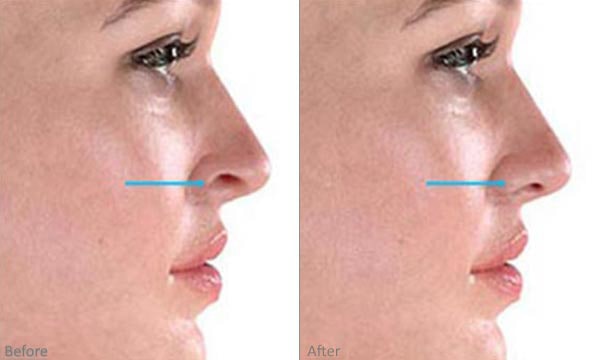
An alar notching can also be due to excessive surgical removal of tissue (over-resection) in skin cancer patients. Other causes include birth defects, family history, and physical trauma.
Also Read: Open vs Closed Rhinoplasty: Everything You Need to Know
An alar rim retraction can be corrected with a revision rhinoplasty if it’s a result of a previous nose surgery, or a primary rhinoplasty, in case it has other causes. The surgeon usually uses a cartilage grafting technique to correct the deformity, which involves taking cartilage from other parts of the patient’s body and placing it in the alar area to fill the hollow area and create a support for the rim. Another treatment option for alar notching is injectable fillers. In this procedure, the specialist injects small amounts of dermal fillers into the alar rim to fill the gap and improve the appearance of the notching. However, this non-surgical alternative isn’t permanent and the results last only for 1-2 years.
Hanging Columella
The columella is the soft tissue at the bottom of the nose that separates the nostrils and connects the nasal tip and base. A hanging columella is a less common nose concern that occurs for different reasons, including a naturally too long nasal septum, excess soft tissue, or a poorly-done previous surgery.
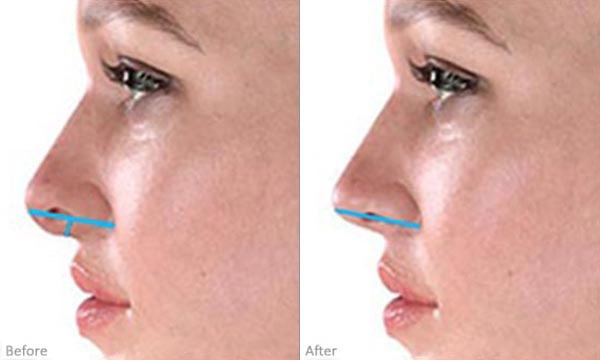
A hanging columella and an alar retraction may be confused because both of them result in too much exposure of the nostrils. However, in an alar retraction, the columella is in the right position relative to the nasal tip and the alar rim is in a higher than normal position, but in a hanging columella the alar rim is in the right position and the columella is in an abnormally lower position than the tip.
A hanging columella is correctable with rhinoplasty, in which the surgeon removes the excess septal cartilage and tissue, lifts up the columella, and fixes it with sutures.
Small Nose (Button Nose)
While the majority of people seeking nose surgery are looking to reduce the size of their nose, some people are unhappy with their too-small nose and want to have an augmentation rhinoplasty. A very small nose is commonly known as a ‘button’ nose and is often characteristic of Asian ethnic groups. A typical button nose has a small rounded nose and a low and curved bridge and is short in length. An augmentation rhinoplasty for a button nose typically involves raising the dorsum of the nose and refining the tip to give it a slimmer appearance.
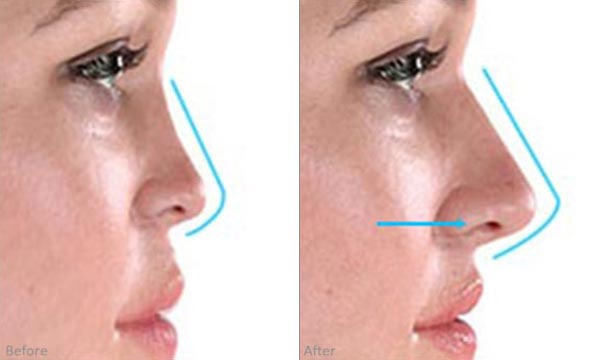
Functional Nose Concerns
There are nose concerns that regardless of whether they have any aesthetic effect on the appearance of the nose, affect the main function of the nose, which is breathing. A rhinoplasty that is performed with the aim of addressing such problems to improve breathing is called a functional rhinoplasty, the most common form of which being septoplasty. Here are the most common functional nasal problems:
Deviated Septum
Other names: septal deviation
A deviated septum occurs when the internal wall between the nostrils called septum shifts to one side, blocking one of the nostrils and consequently the airflow. This may be a congenital problem or have been acquired due to an injury to the nose. The procedure to correct a deviated septum is called a septoplasty, which may or may not be combined with a cosmetic rhinoplasty. (Learn more about this in the Crooked Nose section above.)
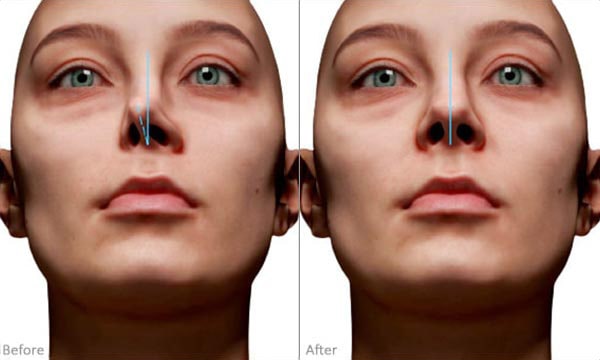
- Consult septoplasty doctors
Nasal flaring
Nasal flaring (not to be confused with alar flare; see above), refers to a condition in which the nostrils widen abnormally when you breathe, typically a sign of having difficulty breathing. While all people may have temporary nasal flaring at times, such as during strenuous exercise, persistent widening of the nostrils may be a sign of an underlying problem. Nasal flaring is more common in children and infants. Common causes include bacterial and viral infections such as pneumonia, flu, bronchitis, and croup, as well as asthma, epiglottitis, and obstruction of the breathing airways caused by a deviated septum or nasal valve collapse (stenosis). Treatment of nasal flaring should focus on identifying the root cause of the problem.
Nasal polyps
Nasal polyps are a painless non-cancerous teardrop-shaped overgrowth of soft tissue inside the nose or sinuses. Small nasal polyps may not be a big deal but larger ones can become troublesome. They can block the airflow and cause difficulty breathing or block the drainage of mucus from the sinuses, causing infection. Nasal polyps can occur at any age but young adults and middle-aged people are at a greater risk of developing them. Treatment options for nasal polyps include medication and nose surgery, which depends on the size and location of the polyps.
Relevant Specialties for Nasal Issue Solutions
These specialties offer solutions for nasal issues, whether they require surgical intervention or not. Procedures include primary and revision rhinoplasty, septoplasty, and non-surgical treatments such as nose fillers, plexer, endolift, etc. The relevant specialties are:
- Plastic Surgery
- ENT (Ear, Nose, and Throat)
Summary
If you're considering rhinoplasty to enhance your nasal appearance or address functional concerns, our experienced team of mediators is here to help. At Belorens, we specialize in connecting individuals with skilled surgeons who can provide personalized solutions for the nose such as rhinoplasty, nose filler, septoplasty, and revision rhinoplasty. Take the first step towards achieving your desired results by scheduling a consultation with us today. Our experts will guide you through the process, answer your questions, and ensure you receive the care you deserve. Don't wait any longer – let us assist you in transforming your nose and boosting your confidence.



